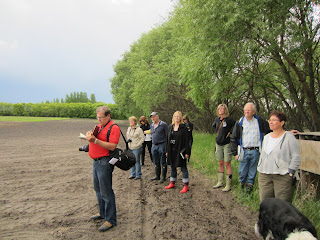Well, it has taken a while (quite a while!) but the hoop house has been planted! I intended to write about it, ooooh, four days ago, but we got busy. We intended to plant it, ooooh, about a month ago, but we got busy. This season has been a little 'nut-so' thus far! Bottle feeding three baby goats four times a day, adding milking to our daily chores twice a day, keeping an eye on the baby chicks, caring for now seemingly motherless kittens: animals are taking up an awful lot of our time and the vegetables are getting somewhat neglected!
Part of the point of a hoop house (or high tunnel, or plastic greenhouse or any of the many names I've seen it called) is to get an early start on the season. We kind of missed that boat, this year. We had to repair it and waited a bit on the plastic. Then we decided to move it, because we wanted to use it again for tomatoes and peppers and didn't want to risk passing disease onto new plants. That was a full day of Farmer Man lifting out the plastic-covered rebar hoops, moving them over then 'planting' each end again. Then measuring and adjusting, to make sure the doors would fit. Then we waited for the perfect calm night, with a couple of extra people around (a garden renter named Kyle and our right-hand man, Henry) and then plastic cover was floated into place. The next day Farmer Man fastened it all in and good-to-go!
One side would be tomatoes, one side would be a double row of assorted hot peppers with some spare ends for some herbs. Farmer Man has the process of planting down to a science. Dig a hole almost as deep as the tomatoes are tall, compost and bone meal in the bottom, bury tomato, back fill, tamp with foot. Tomatoes are one of the few plants that can stand to have their stem buried, and the stem will root, giving you a nice, healthy, strong plant. The bone meal is to provide calcium and prevent blossom end rot. Sometimes we use a little of the oyster shell for the chickens (multi-purpose, love it) although this will be slower to break down. The hardest part of this process was preparing the compost: Farmer Man had to put our compost from the pile through a screen, a job done by the shovel into the wheel barrow to avoid the waste the tractor would cause!
The peppers are largely the same process, just a smaller hole is required as the stem cannot be buried. By late morning, as the planting job was getting finished, it was getting darn hot in there! The peppers and tomatoes will love it; Farmer Man was starting to wilt! We've got basil and parsley in 2" pots ready to fill the corners. Now, we've got to add to the chore list to go and water the hoop house every two days, every day if temperatures are getting to 28C (about 90F) or higher! In this crazy year we worry so much about forgetting things like that!
The daily chore list is constantly changing this year! The kittens will, hopefully, find good homes in the next few weeks. The triplets will go down to feeding three times and day and then to twice a day and then to no bottles at all. The baby chicks are now teenagers and have moved on to 'big chick' feeders and waterers, which don't require filling as often. The veggies will require almost constant care from here on: weeding, watering and soon, harvesting! The work of starting tomato and pepper seeds in February and March: watering and fertilizing, potting up, moving up to the greenhouse, hardening off, planting out....it will all be forgotten when we get that first bite of a fresh, juicy, vine-ripened tomato!
Part of the point of a hoop house (or high tunnel, or plastic greenhouse or any of the many names I've seen it called) is to get an early start on the season. We kind of missed that boat, this year. We had to repair it and waited a bit on the plastic. Then we decided to move it, because we wanted to use it again for tomatoes and peppers and didn't want to risk passing disease onto new plants. That was a full day of Farmer Man lifting out the plastic-covered rebar hoops, moving them over then 'planting' each end again. Then measuring and adjusting, to make sure the doors would fit. Then we waited for the perfect calm night, with a couple of extra people around (a garden renter named Kyle and our right-hand man, Henry) and then plastic cover was floated into place. The next day Farmer Man fastened it all in and good-to-go!
One side would be tomatoes, one side would be a double row of assorted hot peppers with some spare ends for some herbs. Farmer Man has the process of planting down to a science. Dig a hole almost as deep as the tomatoes are tall, compost and bone meal in the bottom, bury tomato, back fill, tamp with foot. Tomatoes are one of the few plants that can stand to have their stem buried, and the stem will root, giving you a nice, healthy, strong plant. The bone meal is to provide calcium and prevent blossom end rot. Sometimes we use a little of the oyster shell for the chickens (multi-purpose, love it) although this will be slower to break down. The hardest part of this process was preparing the compost: Farmer Man had to put our compost from the pile through a screen, a job done by the shovel into the wheel barrow to avoid the waste the tractor would cause!
The peppers are largely the same process, just a smaller hole is required as the stem cannot be buried. By late morning, as the planting job was getting finished, it was getting darn hot in there! The peppers and tomatoes will love it; Farmer Man was starting to wilt! We've got basil and parsley in 2" pots ready to fill the corners. Now, we've got to add to the chore list to go and water the hoop house every two days, every day if temperatures are getting to 28C (about 90F) or higher! In this crazy year we worry so much about forgetting things like that!
The daily chore list is constantly changing this year! The kittens will, hopefully, find good homes in the next few weeks. The triplets will go down to feeding three times and day and then to twice a day and then to no bottles at all. The baby chicks are now teenagers and have moved on to 'big chick' feeders and waterers, which don't require filling as often. The veggies will require almost constant care from here on: weeding, watering and soon, harvesting! The work of starting tomato and pepper seeds in February and March: watering and fertilizing, potting up, moving up to the greenhouse, hardening off, planting out....it will all be forgotten when we get that first bite of a fresh, juicy, vine-ripened tomato!











